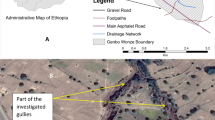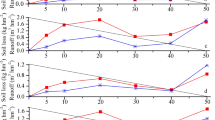Abstract
Scientific evidence for the upper limit of farmland is proposed. Shallow gully erosion is one of erosion types distributed extensively on sloping farmland in the hilly regions of the Loess Plateau. Field observation and aerial photos interpretation, as well as laboratory experiments show that the shallow gully erosion occurring on the steeper farmland in the hilly regions of the Loess Plateau is an important factor leading to intensive erosion on slope, because of its extensive distribution and intensive runoff collection. The data on the formation, development and distribution of shallow gullies on sloping farmland indicate that critical slope gradient for shallow gully initiation ranges from 15 to 20 degrees with an average of 18.2 degrees. Therefore, it is suggested that critical slope gradient for compulsory abandonment of farmland on the hilly Loess Plateau should be kept within the critical slope gradient for shallow gully initiation to prevent shallow gully formation in order to control soil loss more effectively. But as the first step, the cultivation on the slopes with slope larger than 25 degrees where the maximum erosion occurs should be strictly forbidden.
Similar content being viewed by others
References
People’s Republic of China’sLaw for Water and Soil Conservation (in Chinese), Beijing: Chinese Legal System Publishing House, 1991, 4–5.
Tang Keli,Soil Erosion Characteristics and Controlling Methods (in Chinese), Beijing: Chinese Science and Technology Publishing House, 1991, 41–42.
Tang Keli, Xi Daoqing, Song Qinfang, Soil loss from sloping farmland and its control in Xinzihe river basin (in Chinese),Bulletin of Soil and Water Conservation, 1983, 3(5): 43.
Northwestern Institute of Water and Soil Conservation,Natural Resources and Soil and Water Conservation in Xinzihe River on the Loess Plateau (in Chinese), Taiyuan: Shaanxi Sciences and Technology Publishing House, 1986, 41–49.
Zhu Xianmo, Lei Wenjing, Soil erosion and its developing in Jinghe river basin,Acta Pedologica Sinica, 1954, 2(4): 220.
Chen Jicheng, Belts of runoff erosion on slopeland,Trans. Geography Union (in Chinese), Beijing: Science Press, 1963, 99–104.
Cheng Yongzong, Evolution of erosion on slopeland in the hilly region of loess plateau in the middle reaches of Yellow River, inCollected Papers of Geography No 10 (in Chinese), Beijing: Science Press, 1976, 44–47.
Zhang Keli, Tang Keli, Characteristic parameters of shallow gully on the Loess Plateau,Journal of Soil and Water Conservation (in Chinese), 1991, 15(2): 8.
Lei Aling, Tang Keli, Determination of prototype in soil erosion modeling,Journal of Soil and Water Conservation (in Chinese), 1995, 9(3): 60.
Author information
Authors and Affiliations
About this article
Cite this article
Tang, K., Zhang, K. & Lei, A. Critical slope gradient for compulsory abandonment of farmland on the hilly Loess Plateau. Chin. Sci. Bull. 43, 409–412 (1998). https://doi.org/10.1007/BF02883721
Received:
Issue Date:
DOI: https://doi.org/10.1007/BF02883721




